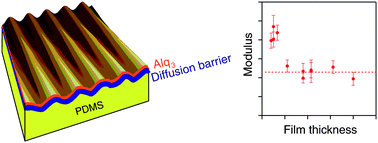Abstract
The intrinsic flexibility of organic molecular films has been suggested to enable bendable electronics in comparison to their stiffer, inorganic counterparts. However, very little is known regarding the mechanical properties of these molecular glasses that are commonly utilized in organic electronics. To begin to address these issues, the elastic modulus of vapor deposited tris(8-hydroxyquinolinato)aluminium (Alq3) films, commonly used in organic light emitting devices (OLEDs), is determined as a function of thickness from 10 nm to 100 nm using a wrinkling-based metrology. These thicknesses correspond well with the range actually utilized in OLEDs. The direct deposition of Alq3 onto a polydimethylsiloxane (PDMS) elastomer results in anomalous results due to diffusion of Alq3 into the PDMS substrate. Conversely, a thin polystyrene (PS) film can be used as a diffusion barrier, enabling the elastic moduli to be accurately measured. Similar to most organic glasses, the Young's modulus of Alq3 is on the order of 1 GPa and is statistically invariant for thicknesses >20 nm. Interestingly, there is a significant increase in the Young's modulus for thinner films. The modulus of a 10 nm Alq3 film is found to be nearly twice that of a thicker film. Corresponding to this change in modulus is a loss of the optical adsorption peak associated with aggregation of Alq3, which suggests that the modulus change is related to the local packing of the molecule. This result illustrates that the thickness of active layers in OLEDs impacts not only the device performance but also their elastic properties, both of which are important for use in flexible devices.

- This article is part of the themed collection: The Physics of Buckling

 Please wait while we load your content...
Please wait while we load your content...